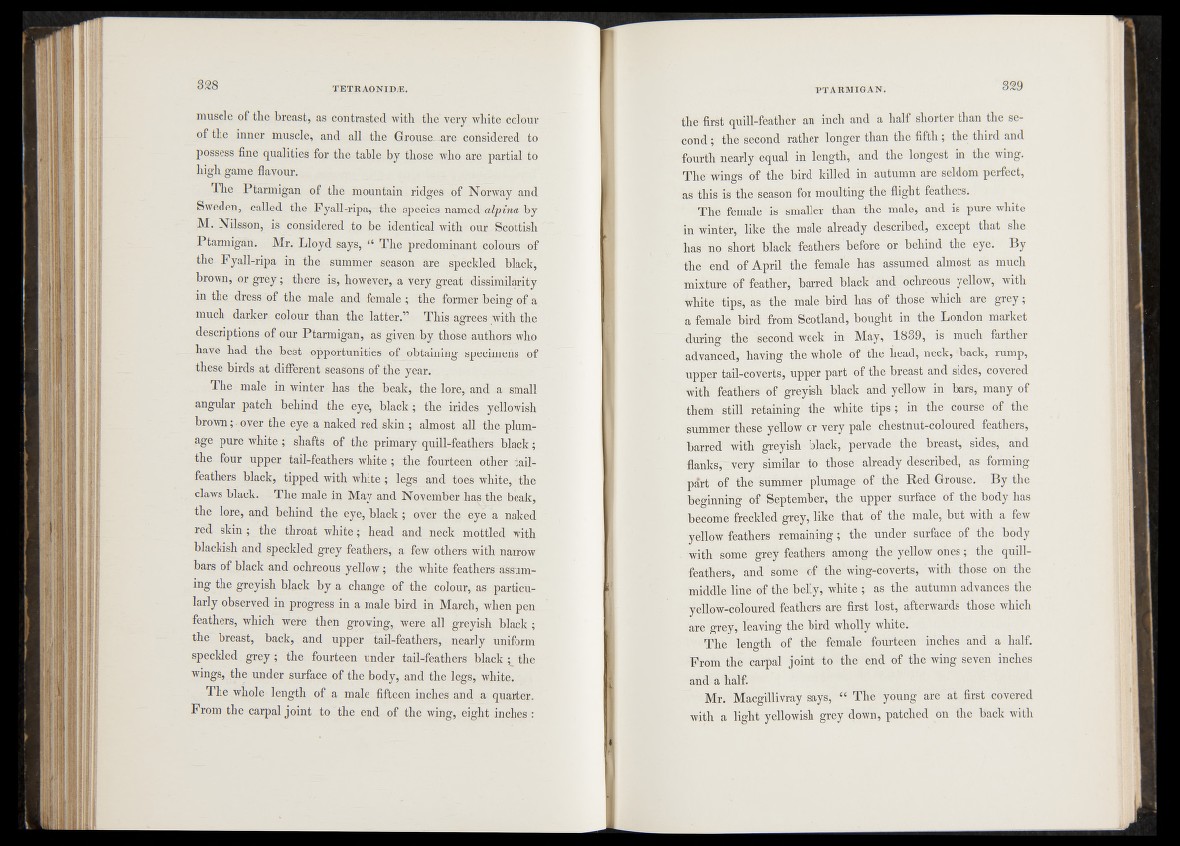
muscle of the breast, as contrasted with the very white, colour
of the inner muscle, and all. the Grouse—are considered to
possess fine qualities for the table, by those who are partial to
high, game flavour.
The Ptarmigan of the mountain ridges of Norway and
Sweden, called the. Fyall-ripa, th e . species named alpina Hy’
M. Nilsson, is. considered to be identical with our Scottish
Ptarmigan. Mr. Lloyd says, “ The predominant colours of
the Fyall-ripa in the summer,. season are speckled black,
brown, or grey; there is, however, a very, great dissimilarity
in the dress of fhe male and female ; the former being o£,a
much darker colour than the latter,” This agrees with tire
descriptions of our Ptarmigan, as given^by. those authors who
have had the best opportunities of. obtaining specimens of
these birds at different seasons of the year.
The male in winter has the beak, the lore, and a sm a ll
angular patch behind the eye,, black; the irides yellowish
brown; over the eye. a naked red .skin ; almost all thuplum-
age pure white; shafts of the primary quill-feathers black;
the four upper tail-feathers white ; the fourteen other tail-
feathers black, tipped with white ; legs and toes white,>4fhe
claws black. The male in May and November Las the beak,
the lore, and behind the eye, black; oyesr-th^ eye a naked
red skin; the throat white; head and neck mottled with
blackish and speckled grey feathers, a feV‘others with narrow
bars of black and ochreous yellow; the. white feathers3assum~
ing the greyish black by a change of the colour, as particularly
observed in progress in a male bird in March, when pen
feathers, which were then growing, were all greyish black ;
the breast, back, and upper tail-feathers, nearly uniform
speckled, grey > the fourteen under tail-feathers black the
wings, the under surface of the body, and the legs, white.
The whole length of a male fifteen inches and a quarter.
From the carpal joint to the end- of the wing, eight inches :
the first quill-feather an inch and a half shorter than the second
; the second rather longer than the fifth; the third and
fourth nearly equal in length,, and the longest in the wing.
The-wings Of the bird killÉI in autumn Sie seldom perfect,
as this is the éeason for moulting the flight feathers.
The female is smaller than the male, and is pure white
in winter, like the' male already described, except that she
has no short black feathers before or behind the eye. By
the end of April the female has assumed almost as much
mixttürë of feather; barred bfefcSf'and £flp*eons yellow, , with
White. tips^ as the male bird has óf those Which are grey;
a female bird from Scotland, bought in the London market
during t^e'second week in M4y, 1839, is much farther
advanced, having the whole' of the head,cneck, ®back, rump,
upper tail-coverts, upper part of the breast' and sides, coverèd
with fe&thers of greyish black and yellow in bars, many of
thefn still' retaining the white tip s; in thé course of the
summer these yellow or very pale' chestnut-coloured feathers,
barred with greyish« black,’pervade"the breast,’ sides, and
flanks,“ very similar to those already dêscribed, as forming
part 'of the summer plumage of thé Red Grouse. By the
beginning of September, the upper surface of the body has
become frèckled grey, like that oL the 'made, but with a few
yellow feathers remaining; the under surface of the body
„ with some grey feathers among the" yellow ones ; the ! quill-
feathers, and some of the wing-coverts, with those on the
middle line of the belly, white ; as the autumn advances the
yelloW-colbured feathers are first 4dstv afterwards those; which
are grey, leaving the bird wholly white.
The length female fourteen inches and a half.
From the carpal joint to the end of the wing seven inches
and a half.
Mr. Macgillivray says; “ The young are at first covered
with a light yellowish grey down, patched on the back with